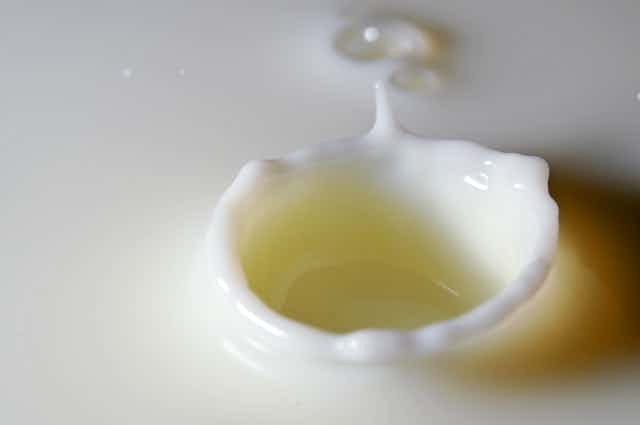Recently the American publication Mother Jones published an article on the dangers of food laced with tiny metal oxide particles. The article, however, is laced with errors and misinformation.
The source material for the article came from a report by the environmental organisation Friends of the Earth, an online database of nanotechnology-based consumer products and a peer-reviewed paper published in 2012. However, the analysis of the information is flawed.
Tom Philpott, author of the Mother Jones article, claims nanoparticles – defined as particles smaller than 100 nanometres, which is a thousandth of the width of a human hair – are used because they behave differently from other particles. He is worried that scientists still don’t know how dangerous these differences make them. He also claims that the US Food and Drug Administration (FDA) has done nothing to slow down their rapid move into the food supply.
Bad journalism
The inventory Philpott cites is the Project on Emerging Nanotechnologies Consumer Products Inventory, which I helped establish in 2006 as a way better understand the increasing number of consumer products that were using engineered nanomaterials. It provides a useful but only qualitative sense of what was being used where, and relies on intermittent web searches and other sources of intelligence. The inventory was never meant to be comprehensive or authoritative.
In 2013 the inventory was updated to include further information on products and materials where it was available. As part of this update, products from a peer review paper published the previous year were included – a study, published in the journal Environmental Science and Technology, reported an analysis of nearly 90 food products for the presence of the material titanium dioxide.
Titanium dioxide has been used widely in foods for decades as a whitener and a base for other colors. It is considered to be an inert and safe material. The US FDA allows food products to contain up to 1% titanium dioxide without the need to include it on the ingredient label, as long as the substance added conforms to stringent levels of purity.
Usually referred to as Food Grade titanium dioxide, or additive E171 in Europe, the white powder is typically made up of particles a few hundred nanometers in diameter – a particle size that reflects visible light extremely well. In the 2012 paper researchers bought a selection of white or pale processed foods and tested them for the presence of titanium dioxide. They discovered that some products contained as high as 0.4% titanium dioxide by weight, and others as little as 0.0002% titanium dioxide by weight. The researchers also measured the particle size of the titanium dioxide particles in some products, and found the majority of particles to be larger than 100 nanometers in diameter, as would be expected for food grade titanium dioxide.
The Project on Emerging Nanotechnologies Consumer Products Inventory currently lists 96 food products that contain nanoparticles. Of these, 89 are taken directly from the paper in Environmental Science and Technology. Of the remaining seven, four are no longer commercially available as far as can be ascertained, one is not an actual product, and one is a dietary supplement. This leaves just one nanotechnology-based food product in the inventory that is still available and doesn’t contain food-grade titanium dioxide.
(Na)no harm
These 89 titanium dioxide containing products represent only a tiny fraction of products that have been available since before the term nanotechnology was popularised. And while they undoubtedly contain some small particles – most powders contain at least a few particles that are nanometer sized – they are there to ensure that the food products have bright, vibrant colors.
But in their report Friends of the Earth used the Consumer Product Inventory to claim there has been:
…a ten-fold increase in unregulated, unlabeled ‘nanofood’ products on the American market over the past six years. In 2008 we found eight food and beverage products with nano-ingredients on the market. In 2014, the number of nanofood and beverage products we know to be on the market has grown to 94.
Their list matches the Consumer Products Inventory, including those items that are either no longer commercially available, or not actual food products. And given that the inventory was updated recently, it is easy to see where the “ten-fold increase” comes from. If the journalist had got in touch with the founders of the inventory, it would have been clear that such an increase says nothing about the real number of food products using titanium dioxide.
Safety first
As someone who works on the risks and benefits of nanotechnology, I can see how errors in translation crept into this story. The 2012 paper was addressing a legitimate concern that little is know about how much titanium dioxide is in the processed food chain. The Consumer Products Inventory provides important and unique insights into nanoparticles being used in products. Friends of the Earth have every right to ask what is known about the potential risks in what we’re eating. And reporters like Philpott have a professional obligation to highlight issues of concern and interest to their readers.
Each player in this case has played a legitimate role. But in this case, Philpott did not take the effort of speaking to experts to hear their views. Instead he bought the line that Friends of the Earth had in their report and wrote an article that only spreads misinformation.
Health journalism is tricky business. Journalists should be extra careful before putting out information in the public domain. They are right to highlight genuine issues, but the least they can do is get experts to weigh in on the debate. Simply basing a report on a one-sided view, which most scientists wouldn’t even agree on, is poor journalism.
Next, read this: The seven deadly sins of health and science reporting

